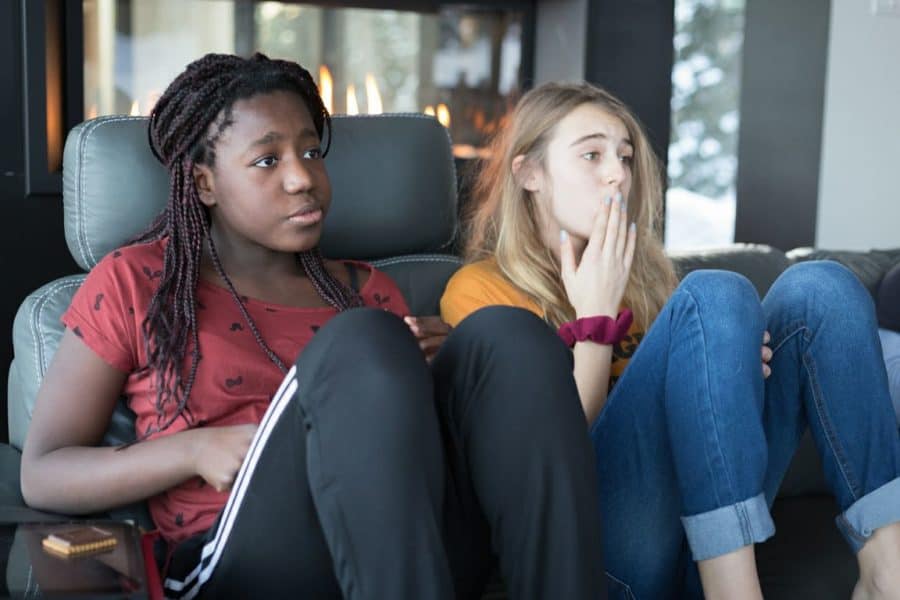The American Dream may have faded, but it is unrealistically — and perhaps detrimentally — alive and well on teenagers’ favorite TV programs, according to a report published today by UCLA’s Center for Scholars and Storytellers.
The persistence in popular entertainment of that dream — that anyone, regardless of their race or socioeconomic status, can achieve success through hard work and talent — ignores not only the stark economic realities of 21st-century America but the systemic inequities faced by people of color and the poor, say the report’s authors, who assessed the ways in which characters on the 10 fictional shows most popular with teens had “made it.”
The researchers discovered that while more than 60% of characters achieved financial success and social mobility by dint of their personality, work ethic and morality, only 28% of hardworking, moral characters were stymied in their efforts. Even more improbably, the authors say, characters of color in these programs were by far the most likely to achieve the American Dream.
“TV portrays people of color achieving the American Dream nearly twice as often as their white counterparts — this inaccurate depiction is a reverse of racial realities,” said the report’s senior author, Yalda Uhls, founder and executive director of the center and a UCLA adjunct assistant professor of psychology.
She noted that 63% percent of Black children in lower-class families have remained lower-class as adults, according to recent research, and that downward mobility for Black Americans is about twice the rate of whites.
These TV depictions, Uhls said, may shape class, racial and cultural perceptions for impressionable teen audiences in ways that are not reflective of reality. She suggests grounding shows in real struggles faced by real people rather than peddling financial fairytales.
“While it’s important not to reinforce economic stereotypes along racial lines,” she said, “it’s equally important to write stories that show the reality of systemic inequity and the barriers to getting ahead.”
The report analyzed the 10 shows most popular with kids between the ages of 13 and 17 in 2019. Because of the broad accessibility of streaming services, the programs ranged from those produced in the 1990s (“Friends”) and the 2000s (“The Office,” “Grey’s Anatomy” and “Supernatural”) to those made in the 2010s (“Brooklyn Nine-Nine,” “Lucifer,” “Jane the Virgin,” “Riverdale,” “Arrow” and “The Flash”).
The researchers found that most programming provided an unreal picture of economic realities and the American Dream.
In terms of screen time, the rich get richer, the poor get poorer
For decades, popular TV shows have focused primarily on the middle class. More recently, however, wealthy characters have taken center stage while poor and working-class characters have fallen out of view. In fact, the report shows, programs produced after 2010 had twice as many wealthy characters as those made in the 1990s — and nearly 90% fewer poor characters.
“The poor are nearly nonexistent on the shows most popular with teens, while the middle and upper classes are overrepresented,” Uhls said. “But in reality, increased income inequality has led to a vanishing middle class and an increase in poverty. Stagnating wages and income inequality mean that the American Dream of out-earning one’s parents is nearly impossible for future generations.”
Still, research has shown that most Americans overestimate upward mobility, and younger people seem to have a particularly exaggerated sense of the possibility of improving their social and financial status, Uhls said. TV may play a role in that.
“Based on their consumption of media, teens may believe that upward mobility and success is a given,” she said. “But if systemic inequities make the dream nearly impossible to achieve, they may feel they only have themselves to blame.”
Helping creators craft content that reflects reality
Uhls and her co-authors say they hope their report will spur creators of television programs to focus on more truthful stories with realistic characters, which could help pave the way toward social change.
And when crafting shows that incorporate the American Dream, it’s especially important to highlight the barriers that may keep social mobility out of reach, said Alicia McLauchlin, the report’s first author, who graduated from UCLA this year with a bachelor’s degree in psychology.
“As someone who grew up with substantial economic hardship, the inclusion of characters enduring economic adversity has always felt incredibly important, meaningful and often inspirational,” she said. “Those types of characters were always my favorites. They were born into bad situations and through strength and resilience, they improved their situations.”
McLauchlin said the inclusion of characters who tenaciously fight for their place in a world in which they are systemically impoverished offers an engaging narrative for many young viewers who might lack access to resources and are themselves becoming increasingly economically marginalized.
Stories have enormous power to influence how teenagers and children understand their culture and environment, Uhls said, and “storytellers have an important opportunity to examine and combat stereotypes. We hope our findings can help begin the conversation.”
Other co-authors of the report are Nenita Alexa Mugol, Zuri Smith, Maeve O’Sullivan and Brian McAuley — all of whom are fellows or research assistants with the center.
For the study, the researchers analyzed the economic representation of TV characters with the help of a survey of 100 participants whose ages ranged from 13 to 68 (average age of 29), 59% of whom were female. The authors also conducted a content analysis of tropes and stereotypes.


